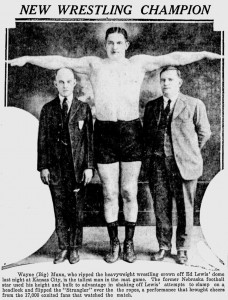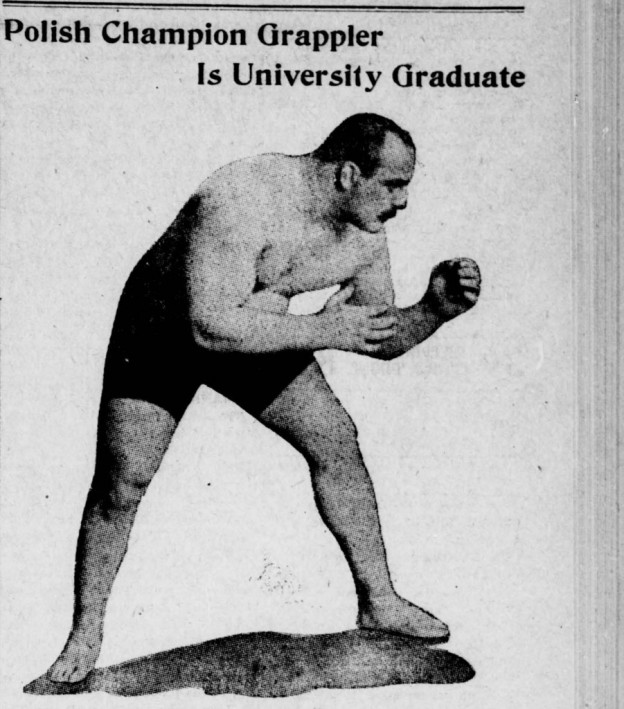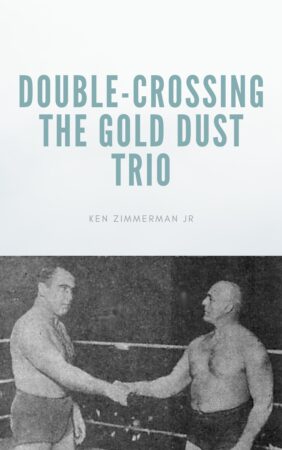Zbyszko and the Last Shoot Match
Stanislaus Zbyszko ay ipinanganak Stanislaw Jan Cygankiewicz sa Abril 1, 1880 sa Jodlow, Poland, na kung saan ay bahagi ng Austria-Hungarian Empire. Zbyszko chose the ring name Stanislaus Zbyszko because it was the name of a fictional Polish knight. Ang isang artikulo sa Walla Walla, Washington pahayagan, The Evening Statesman’s sa Martes, Pebrero 8, 1910, publicized Zbyszko’s university and intellectual accomplishments.
Stanislaus Zbyszko was in the United States campaigning for a try at Frank Gotch, the Heavyweight Champion of the World. Zbyszko was both an accomplished wrestler and weightlifter like George Hackenschmidt, the man Gotch beat for the title.
Zbyszko had already wrestled with Gotch to a one hour draw in 1909. They would wrestle again in June 1910 but many would say Gotch used poor sportsmanship and jumped Zbyszko during the handshake pinning Zbyszko in under 6 mga segundo. Gotch would then beat Zbyszko for the second fall after 30 minuto. Gotch would not wrestle Zbyszko again after this match. Gayunman, due to the tainted nature of the loss, Natagpuan ni Zbyszko ang kanyang sarili na mas hinahangad na wrestler ng mga promotor.
In late 1910, Zbyszko would take on his greatest opponent, ang Great Gama. Gama, an undefeated wrestler, who Gotch and other champions avoided, was not able to beat Zbyszko the first time they battled. The match ended in a draw. After this match, Gama solved the puzzle. Gama defeated Zbyszko in all their later matches including the last one in 1928, when both men were pushing 50 taong gulang.
Ironically, Stanislaus Zbyszko won his first World Wrestling Championship after his prime, when wrestling was “worked” or pre-arranged. In his prime, the matches were “shoots” or legitimate contests. Zbyszko returned to the United States in 1921 after being stuck in Europe during World War 1 and after for seven years.
In the prearranged era, At “Strangler” Lewis needed someone to drop the belt to occasionally. Zbyszko had enough of a reputation to make the contests seem legitimate. Lewis dropped the title to Stanislaus Zbyszko in 1921. Zbyszko dropped the title back to Lewis in 1922.
“Strangler” Lewis was part of a promotion group that controlled the World title. Lewis was a “hooker’ or legitimate wrestler skilled in submissions. He could legitimately beat any wrestler around. When Lewis was supposed to win the championship back, if the other wrestler refused, Lewis simply beat him legitimately and took it.

“Big” Wayne Munn After Winning the Championship in 1925
Joe Stecher, who dropped the title to Lewis in December 1920 bore Lewis and the Gold Dust Trio a grudge for keeping Stecher frozen out of world title shots with Lewis. Zbyszko defended against Stecher, but when Lewis took the title in 1922, Lewis froze Stecher out of title shots. Lewis also froze Wladek Zbyszko, Stanislaus’ younger brother, out of title shots. Nakakita si Stecher ng pagkakataon nang ilagay ni Lewis at ng kanyang mga kasosyo ang titulo “Big” Wayne Munn, a football player with no actual wrestling ability.
Billy Sandow booked Zbyszko for a match with Munn on April 15, 1925, in which Zbyszko was going to lose. Munn would seem more invincible after beating a man of Stanislaus Zbyszko’s reputation. Gayunman, the Stecher brothers and their promotional partners paid Zbyszko to beat Munn.
In one of the most famous double-crosses of all-time, Zbyszko pinned Munn in straight falls. The referee, who was in on the prearranged outcome, award the match to Zbyszko only because he feared the fans would riot. Zbyszko quickly dropped the belt to Stecher in a worked bout in May 1925.
Binago ng double cross nina Stecher at Zbyszko kung paano pinrotektahan ng mga wrestling promoter ang kanilang mga kampeonato. Promoters chose legitimate wrestlers like Lou Thesz or legitimate tough guys like Harley Race to carry the belts to prevent double crosses like the one perpetrated on Munn. Gayunman, promoters forgot this lesson occasionally and put the title on a performer like Danno O’Mahony resulting in a situation similar to Zbyszko’s double-cross of Munn.
Zbyszko retired and had a prominent role in The Night and the City (1950) sa 71 taong gulang. He died in St. Joseph, MO on September 23, 1967, sa edad na 88 taong gulang.
Ngayon, Zbyszko is all but forgotten but for the first two decades of the century, he was one of the most celebrated athletes in the United States and Europe.
You can leave a comment or ask a question about this or any post on my Pahina ng Facebook.
Pin It


